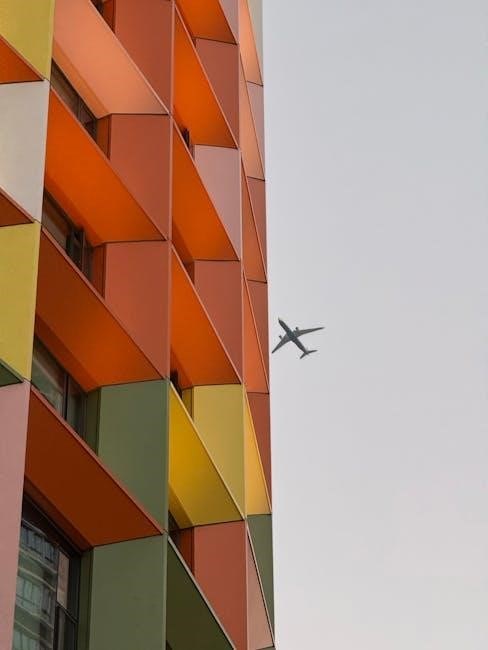Overview of “Martian Metropolis” by Meg Thacher
Martian Metropolis by Meg Thacher is a short text in the HMH Into Literature curriculum, exploring the science and challenges of colonizing Mars. It examines cosmic radiation, atmospheric issues, and resource utilization, serving as a valuable educational resource for science and urban planning studies.
Martian Metropolis by Meg Thacher is a thought-provoking article that introduces readers to the concept of colonizing Mars. It is part of the HMH Into Literature curriculum for 7th grade, designed to align with educational standards and foster critical thinking. The article explores the challenges of establishing a human settlement on Mars, focusing on scientific, technological, and societal aspects. Thacher discusses key issues such as cosmic radiation exposure, the thin Martian atmosphere, and the need for resource utilization. The text also highlights the importance of urban planning and ethical considerations in building a functioning society on Mars. As a companion to textbooks, Martian Metropolis engages students with activities, questions, and signposts for comprehension, making it a valuable resource for integrating science and literature.
Author Background and Intentions
Meg Thacher, the author of Martian Metropolis, is known for her work in science writing and education. Her intention in writing this article was to educate students about the possibilities and challenges of colonizing Mars. Thacher aimed to make complex scientific concepts accessible to younger audiences, aligning her work with educational curricula. By exploring themes like cosmic radiation and resource utilization, she highlights the importance of science and urban planning in creating a sustainable Martian society. Thacher’s goal is to inspire critical thinking and curiosity among students, encouraging them to consider both the benefits and risks of space exploration. Her work serves as a valuable resource for integrating science and literature in the classroom.
Central Idea and Key Themes
The central idea of Martian Metropolis by Meg Thacher is the exploration of Mars colonization, focusing on both the possibilities and challenges. Key themes include the feasibility of establishing a human settlement, overcoming obstacles like cosmic radiation, and utilizing Martian resources for survival. Thacher also delves into the societal aspects of building a functioning community on Mars, emphasizing the importance of urban planning and ethical considerations. The article highlights the balance between scientific advancements and human adaptability, encouraging readers to think critically about the future of space exploration. By addressing these themes, Thacher provides a comprehensive overview of the complexities involved in creating a sustainable Martian metropolis.
Scientific and Technological Aspects
Martian Metropolis delves into the scientific challenges of colonizing Mars, such as cosmic radiation, thin atmosphere, and resource utilization. It highlights the technological solutions needed for survival and sustainability on the Red Planet.
The Feasibility of Colonizing Mars
The article explores the feasibility of colonizing Mars, highlighting key challenges such as harmful cosmic radiation, thin atmospheric conditions, and the need for sustainable resource use. It discusses how settlers would face significant hurdles in establishing a habitable environment, emphasizing the importance of advanced technological solutions. The text also examines the potential for using Martian resources, such as water extraction, to support life and construction. While the idea of colonizing Mars is intriguing, the practical difficulties, including long-term survival and societal adaptation, raise important questions about its viability. The author underscores the necessity of careful planning and innovation to overcome these obstacles, making the Martian metropolis a complex yet fascinating concept for future exploration and urban development.
Cosmic Radiation and Its Effects on Settlers
Cosmic radiation poses a significant threat to settlers on Mars, as the planet’s thin atmosphere offers minimal protection. The article highlights how prolonged exposure to harmful radiation increases cancer risks and damages DNA. Galactic cosmic rays and solar flares are identified as primary sources of this radiation. Shielding and protective habitats are essential to mitigate these risks. The text emphasizes the need for advanced materials and architectural designs to safeguard both settlers and electronic systems. Understanding radiation effects is crucial for developing sustainable living solutions on Mars, ensuring the health and safety of future colonists. This challenge underscores the importance of technological innovation in overcoming the harsh Martian environment.
Martian Atmosphere and Breathing Challenges
Mars’ thin atmosphere, composed mostly of carbon dioxide, presents significant breathing challenges for settlers. Unlike Earth’s atmosphere, which is rich in oxygen, Mars’ air is insufficient to sustain human life without assistance. The article explains that even if the atmosphere were denser, it would still be unbreathable due to its composition. This necessitates the development of advanced oxygen production systems and pressurized habitats. The harsh environment requires innovative solutions to create a breathable air supply, either by extracting oxygen from Martian resources or transporting it from Earth. These challenges highlight the critical need for technological advancements to support human survival and long-term habitation on the Red Planet.
Using Martian Resources for Survival
The article emphasizes the importance of leveraging Martian resources to sustain human life and construction. Water extraction from Martian ice is crucial for life support and rocket fuel. Recycling systems will be essential to minimize reliance on Earth-based supplies. Additionally, the planet’s regolith can be used to construct habitats, reducing the need for transported materials. Producing oxygen through chemical reactions involving Martian soil and water is another critical aspect. These strategies highlight the necessity of resourcefulness and innovation in creating a self-sufficient Martian society, ensuring that settlers can thrive despite the planet’s harsh conditions.

Societal and Human Elements
The article delves into the social dynamics of a Martian society, highlighting how interactions between people and ideas will shape the colony’s development and cultural identity.

Challenges of Building a Functioning Society on Mars
Establishing a functioning society on Mars presents significant challenges, including isolation, psychological stress, and the need for reliable food production. The Martian environment, with its harsh conditions, requires settlers to adapt to low gravity and radiation exposure, which can impact health and morale. Additionally, the lack of existing infrastructure necessitates the creation of sustainable systems for energy, water, and waste management. These challenges highlight the importance of urban planning and resourcefulness in designing habitats that can support long-term human presence. The article emphasizes the need for innovative solutions to overcome these obstacles, ensuring the survival and well-being of Martian settlers.
Interactions Between People and Ideas on Mars

On Mars, interactions between people and ideas will play a crucial role in shaping the colony’s development. The isolation of Martian settlers will foster unique social dynamics, encouraging collaboration and innovation. As individuals from diverse backgrounds come together, they will share perspectives, leading to creative solutions for challenges like resource scarcity and habitat design. The exchange of ideas will be vital for addressing technological and societal needs, promoting a culture of adaptability and resilience. These interactions will not only drive progress but also influence the cultural identity of the Martian community, blending traditions from Earth with new norms born out of necessity. This synergy between people and ideas will be essential for building a thriving and sustainable society on the Red Planet.
The Role of Urban Planning in a Martian City
Urban planning plays a pivotal role in the development of a Martian city, as outlined in Meg Thacher’s Martian Metropolis. The design of habitats, resource distribution, and infrastructure must prioritize sustainability and efficiency due to the planet’s harsh environment. Planners will need to create self-sustaining systems for air, water, and food production, ensuring the colony’s survival. The layout of the city should also address radiation shielding, gravity mitigation, and psychological well-being. Public spaces and transportation networks will be designed to foster community interaction and adaptability. Urban planning on Mars will require innovative solutions to balance functionality with the challenges of an alien landscape, making it a cornerstone of establishing a viable human settlement.
Ethical Considerations of Mars Colonization
Meg Thacher’s Martian Metropolis delves into the ethical dilemmas surrounding Mars colonization, raising questions about humanity’s right to expand to another planet. Key concerns include the potential environmental impact on Mars, the displacement of future indigenous life, and the moral obligation to prioritize Earth’s sustainability before pursuing interplanetary habitation. Additionally, the article highlights issues of equity, such as who gets to be part of the Martian society and whether the opportunity will be accessible to all or reserved for the privileged. These ethical challenges underscore the need for a balanced approach that considers both the benefits and risks of colonizing Mars, ensuring that human progress does not come at the expense of moral responsibility.

Educational and Curriculum Integration
Martian Metropolis aligns with the HMH Into Literature curriculum, offering activities and questions that support 7th-grade learning. It serves as a valuable companion resource for science and literature studies.

Alignment with HMH Into Literature Curriculum
Martian Metropolis is specifically included in the HMH Into Literature curriculum for 7th grade, making it a seamless addition to classroom studies. The article aligns with the curriculum’s focus on science, technology, and society, providing a real-world context for learning. It incorporates key reading strategies such as identifying signposts—like numbers and stats, word gaps, and big questions—to enhance comprehension. These tools help students uncover the author’s purpose and bias, making the text engaging and thought-provoking. Activities and questions accompany the article, ensuring it meets educational standards and promotes critical thinking. By integrating Martian Metropolis into the curriculum, educators can foster a deeper understanding of both literary and scientific concepts, preparing students for advanced studies in STEM and beyond.
Skills and Standards Covered in the Unit
The unit on Martian Metropolis is designed to enhance critical thinking, reading comprehension, and analytical skills. Students learn to identify and interpret key concepts, such as the challenges of colonizing Mars, through activities tailored to meet educational standards. The curriculum emphasizes the use of signposts—like numbers and stats, word gaps, and big questions—to guide comprehension and uncover the author’s intent. Vocabulary development is also a focus, with terms like atmosphere and radiation explored in context. By engaging with the text, students practice evidence-based reasoning and reflective thinking, aligning with skills outlined in the HMH Into Literature framework. This unit supports a well-rounded education, blending science, literacy, and critical analysis to prepare students for advanced academic challenges.
Activities and Questions for Student Engagement
The unit includes various activities to engage students with Martian Metropolis. Reading comprehension questions prompt students to analyze key concepts, such as challenges faced by settlers and the role of urban planning. Vocabulary exercises focus on terms like atmosphere and radiation, encouraging students to use context clues. Interactive discussions and debates explore the ethical implications of Mars colonization. Additionally, students participate in project-based learning, designing Martian cities or solving resource challenges. Flashcards and quizzes, such as those on Quizlet, reinforce learning. These activities foster critical thinking, collaboration, and creativity while aligning with educational standards. They ensure students are actively involved in understanding and applying the text’s central ideas.
Using the Article as a Companion to Textbooks
Martian Metropolis serves as an excellent companion to textbooks, offering a real-world application of scientific concepts. Aligned with the HMH Into Literature curriculum, it provides supplementary material that complements traditional textbooks. The article enhances learning by presenting complex ideas in an engaging, accessible format. Teachers can integrate the text into lesson plans, using its questions, activities, and vocabulary exercises to reinforce classroom instruction. Printable and digital versions of the resource cater to diverse learning environments, ensuring flexibility for educators. This companion resource bridges the gap between theoretical knowledge and practical application, making it an invaluable tool for cross-curricular studies. It also encourages students to think critically about science, urban planning, and ethics, fostering a deeper understanding of interdisciplinary connections.
Key Concepts and Vocabulary
Atmosphere and radiation are central terms, explaining Mars’ environment and hazards. Signposts like “Big Questions” and “Word Gaps” guide comprehension, revealing the author’s purpose and scientific concepts.
Understanding Key Terms Like “Atmosphere” and “Radiation”
The article Martian Metropolis introduces key scientific terms like atmosphere and radiation, essential for understanding Mars’ environment. The atmosphere refers to the layer of gases surrounding Mars, much thinner than Earth’s, making it unsuitable for human breathing. Radiation highlights the harmful cosmic rays that pose risks to settlers due to Mars’ lack of magnetic field. These terms are crucial for grasping the challenges of colonization. The text also uses signposts like “Big Questions” and “Word Gaps” to guide readers in understanding complex concepts. By defining these terms, the author helps students connect scientific ideas to the practicalities of building a Martian society, emphasizing the need for advanced technology and protective measures.

Signposts for Reading Comprehension
The article Martian Metropolis employs specific signposts to enhance reading comprehension, such as Numbers and Stats, Word Gaps, and the Big Question. These elements guide readers in identifying key points and understanding the author’s purpose. Numbers and Stats provide factual data, like the thickness of Mars’ atmosphere, offering concrete evidence. Word Gaps require readers to infer meanings using context, engaging them actively. The Big Question encourages critical thinking about whether space exploration is an adventure or a risk. These signposts help students analyze the text deeply, making connections between scientific challenges and the feasibility of Martian colonization while revealing the author’s bias toward the importance of pursuing Mars exploration despite its dangers.
Numbers, Stats, and Word Gaps in the Text
The article incorporates specific numbers and statistics to emphasize key scientific challenges, such as the thickness of Mars’ atmosphere and the effects of cosmic radiation. These numerical details provide concrete evidence for the author’s arguments about the feasibility of colonization. Word gaps, such as terms like “atmosphere” and “radiation,” require readers to use context clues or prior knowledge to understand their meanings. For example, the text explains that Mars’ atmosphere is too thin for human breathing, highlighting the need for artificial environments. These elements engage readers and help them grasp the technical aspects of Martian colonization, while also underscoring the author’s central idea about the challenges and necessity of pursuing Mars exploration.

Big Questions and Author’s Bias or Purpose
The article raises essential questions about humanity’s future, such as whether Mars can sustain human life and the ethical implications of colonization. The author, Meg Thacher, seems to emphasize the challenges of establishing a Martian society, possibly to caution against overly optimistic views of colonization. By highlighting scientific hurdles like cosmic radiation and atmospheric issues, Thacher underscores the complexity of making Mars habitable. Her purpose appears to be informative, aiming to educate readers about the realities of space exploration while encouraging critical thinking about its feasibility and moral dimensions. The text invites readers to consider both the potential benefits and the significant obstacles, reflecting a balanced yet cautious perspective on Martian colonization.

Legacy and Future Implications
Martian Metropolis inspires critical thinking about space exploration, influencing future discussions on Mars colonization. Its insights contribute to science writing and educational resources, shaping perspectives on interplanetary habitation.
The Impact of “Martian Metropolis” on Science Writing
Martian Metropolis has significantly influenced science writing by making complex concepts accessible to younger audiences. Meg Thacher’s work highlights the importance of clear, engaging storytelling in scientific discourse, inspiring future writers to simplify intricate ideas without losing depth. The article’s alignment with educational curricula demonstrates how science writing can serve as a bridge between academic and popular audiences. Its focus on Mars colonization sparks curiosity, encouraging students to explore STEM fields. Thacher’s structured approach, blending scientific facts with real-world challenges, sets a precedent for impactful science communication. This text not only educates but also motivates readers to think critically about humanity’s role in space exploration, leaving a lasting legacy in science education and writing.
Future Prospects for Mars Colonization
As explored in Martian Metropolis, the future of Mars colonization hinges on overcoming challenges like radiation exposure, atmospheric limitations, and resource scarcity. Advances in technology and infrastructure, such as inflatable habitats and in-situ resource utilization, are expected to pave the way for sustainable settlements. The article suggests that within the next few decades, Mars could become a hub for scientific research and innovation, potentially evolving into a self-sufficient society. Urban planning and collaboration between Earth and Mars will play crucial roles in shaping this new frontier. While the journey is fraught with risks, the long-term vision is one of hope and possibility, where humans can thrive on the Red Planet and expand their presence in the cosmos. This vision underscores the importance of continued exploration and investment in Martian colonization efforts.
Lessons Learned from the Article

Martian Metropolis offers valuable insights into the challenges and opportunities of Mars colonization. The article highlights the importance of addressing cosmic radiation, atmospheric limitations, and resource utilization to ensure settler survival. It also underscores the need for meticulous urban planning and societal collaboration to build a functional Martian city. A key takeaway is the balance between technological advancement and ethical considerations, emphasizing that colonization must prioritize sustainability and equity. The text serves as a reminder of humanity’s potential to adapt and innovate, while also cautioning against underestimating the complexities of establishing a new society. These lessons not only inform scientific discussions but also inspire critical thinking about the future of space exploration and its implications for Earth and beyond.
The article concludes by emphasizing the challenges and opportunities of Mars colonization, highlighting the need for innovation and ethical planning. Additional resources include Quizlet flashcards and HMH curriculum materials for further exploration of the topic.
Martian Metropolis by Meg Thacher delves into the feasibility and challenges of colonizing Mars, discussing cosmic radiation risks, atmospheric limitations, and resource utilization. It highlights the need for innovative solutions to establish a sustainable human settlement, emphasizing the importance of urban planning and ethical considerations. The article also explores how societal structures and human interactions might evolve on Mars, balancing scientific realities with visionary ideas. By addressing both technological and societal aspects, Thacher provides a comprehensive overview of the potential for a Martian metropolis, inspiring critical thinking about space exploration and its implications for humanity.
Further Reading and Study Materials
For deeper exploration of Martian Metropolis, students can use Quizlet flashcards to review key terms like “atmosphere” and “radiation.” Additional resources include urban planning guides, such as The First City on Mars by Justin Hollander, which complements Thacher’s insights. Educational platforms offer activities aligned with HMH Into Literature, including reading comprehension questions and vocabulary exercises. To enhance understanding, students can explore NASA’s Mars exploration updates and scientific studies on cosmic radiation. These materials provide a well-rounded approach to studying the challenges and possibilities of Mars colonization, fostering critical thinking and interdisciplinary learning.
